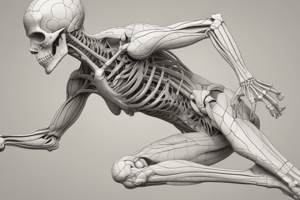Podcast
Questions and Answers
Which of these are the main categories of movements at synovial joints? (Select all that apply)
Which of these are the main categories of movements at synovial joints? (Select all that apply)
- Special movements (correct)
- Gliding (correct)
- Rotational movements
- Angular movements (correct)
What is gliding movement?
What is gliding movement?
Simple movement in which nearly flat bone surfaces move back-and-forth and side-to-side with respect to one another.
What is an example of gliding movement?
What is an example of gliding movement?
The intercarpal and intertarsal joints.
What are the major angular movements?
What are the major angular movements?
What is flexion?
What is flexion?
What is extension?
What is extension?
What is lateral flexion?
What is lateral flexion?
What is hyperextension?
What is hyperextension?
What is abduction?
What is abduction?
What is adduction?
What is adduction?
What is circumduction?
What is circumduction?
What is rotation?
What is rotation?
What are the special movements?
What are the special movements?
What is elevation?
What is elevation?
What is an example of elevation in the human body?
What is an example of elevation in the human body?
What is depression?
What is depression?
What is an example of depression in the human body?
What is an example of depression in the human body?
What is protraction?
What is protraction?
What is an example of protraction in the human body?
What is an example of protraction in the human body?
What is retraction?
What is retraction?
What is inversion?
What is inversion?
What is eversion?
What is eversion?
What is dorsiflexion?
What is dorsiflexion?
When does dorsiflexion occur?
When does dorsiflexion occur?
What is plantar flexion?
What is plantar flexion?
When does plantar flexion occur?
When does plantar flexion occur?
What is supination?
What is supination?
What is pronation?
What is pronation?
What is opposition?
What is opposition?
Flashcards are hidden until you start studying
Study Notes
Types of Movements at Synovial Joints
- Movements at synovial joints are classified into four categories: gliding, angular movements, rotation, and special movements.
Gliding Movements
- Simple motion where flat bone surfaces slide back-and-forth and side-to-side against each other.
- Example locations include intercarpal and intertarsal joints.
Angular Movements
- Result in an increase or decrease in the angle between articulating bones.
- Major types include:
- Flexion: Decreases the angle between bones.
- Extension: Increases the angle, often restoring the anatomical position.
- Lateral flexion: Sidewise bending of the spine.
- Hyperextension: Extending beyond the normal anatomical position.
- Abduction: Movement away from the midline of the body.
- Adduction: Movement toward the midline.
- Circumduction: Circular movement of the distal end of a body part.
Rotation
- Involves a bone revolving around its own longitudinal axis.
Special Movements
- Unique motions occurring at specific joints, including:
- Elevation: Moving a body part superiorly.
- Depression: Moving a body part inferiorly.
- Protraction: Moving a body part anteriorly in the transverse plane.
- Retraction: Returning a protracted part to anatomical position.
- Inversion: Medial movement of the sole at intertarsal joints (supination).
- Eversion: Lateral movement of the sole at intertarsal joints (pronation).
- Dorsiflexion: Bending the foot upward at the ankle.
- Plantar flexion: Bending the foot downward at the ankle.
- Supination: Forearm movement turning the palm anteriorly.
- Pronation: Forearm movement turning the palm posteriorly.
- Opposition: Ability of the thumb to touch the tips of other fingers.
Examples of Special Movements
- Elevation: Example includes closing the mouth at the temporomandibular joint.
- Depression: Example includes opening the mouth to lower the mandible.
- Protraction: Example of thrusting the mandible outward.
- Inversion: Supination occurs at intertarsal joints.
- Eversion: Pronation occurs at intertarsal joints.
- Dorsiflexion: Happens when standing on heels.
- Plantar flexion: Happens when standing on tiptoes.
Studying That Suits You
Use AI to generate personalized quizzes and flashcards to suit your learning preferences.




